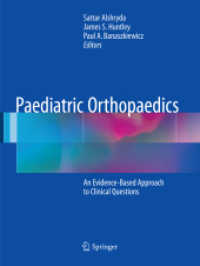- ホーム
- > 洋書
- > 英文書
- > Business / Economics
Full Description
This book investigates over 30 major catastrophes and reveals the critical necessity of transitioning from identifying lessons to implementing actionable changes in workplace safety.
Recognising the gap between incident analysis and meaningful workplace transformation, the book advocates for a shift in mindset, emphasising practical application over theoretical comprehension. This book delivers a comprehensive framework that connects incident findings and tangible and practical workplace improvements. Building upon the works of renowned safety science thinkers, including Sidney Dekker and James Reason, the book offers insights garnered from years of industry experience, delivering a pragmatic approach that is usable in any workplace. New to this edition are two new chapters, updated content on lessons learned from investigations, and increased coverage of the process required to better understand workplace fatalities. Through investigating common drivers of disasters, from the Herald of Free Enterprise ferry tragedy to the Fukushima Daiichi meltdown, the reader will gain an understanding of what can be learned from past incidents and how that can be applied to ensure a safer future.
This second edition of Simplicity in Safety Investigations: Moving Towards Learning from Incidents is an indispensable resource tailored for those in occupational health and safety practice, including supervisors, managers, and business leaders across diverse industries.
Contents
Acknowledgements ix
Early thoughts xi
Introduction xiii
What does this edition cover? xv
Chapter 1 Learning, mindset, and approach 1
What is learning? 1
Mindset 2
Approach 6
Chapter essentials 7
Chapter 2 Before you start 8
Key decisions: study level, scope, team formation, and roles 8
Learning Study level 8
Scope and team formation 9
A simple study 10
A detailed study 11
Roles 13
The art of facilitation and using a coaching style in facilitation 14
Your conversations and questions (before and after an event) 19
Chapter essentials 19
Chapter 3 Getting to 'lessons to be learnt' - the process 20
Step 0: Immediate response (Pre-Learning Study work) 20
Step 1: A decision to undertake a Learning Study is made 21
Step 2: Preliminary information gathering is completed 22
A side note on post-incident conversations/ interviewing (as compared to taking statements) 23
Generous listening 25
The interview conversation 27
Step 3: A Learning Study team is formed 29
Step 4: The team goes through the draft Work-As-Done timeline 29
Step 5: More comprehensive information gathering is undertaken by the team, including a PEEPO 30
How to run an effective and efficient PEEPO 31
Step 6: The timeline is completed, and 'Elements of Interest' are identified (determining Work-As-Done, Work- As-Normal, and Work-As-Written) 33
A side note on the differences between WAD, WAN, and WAW 33
Step 7: The contributors are listed for each Element of Interest 42
Hazards and risks 45
Understanding hazards, risk, and controlling of risk 46
Systems of work and their interrelationships 47
Shared space as it relates to safe workspaces 47
The limitations and use of situational awareness 48
Attitude and mindset 48
Understanding their 'why' 48
The importance of attitude, internal decisions, and sense-making 49
The adoption of a growth mindset, including a learning mindset 49
Competency 50
Core 'competency training' and 'awareness induction' 50
Experience 50
Process, tools, and equipment 51
Understanding of process and equipment 51
Equipment, tools, and plant design 51
Planning and task assignment 51
Task planning, assignment, acceptance, and monitoring, including communication 52
Understanding their own and others' expectations 52
Answering a different question - that is, when the action doesn't match the request 53
What-You-See-Is-All-There-Is and plan continuation 53
Efficiency-Thoroughness Trade-Off 54
Drift 54
Leadership 54
Leadership 54
Accountability and authority mismatch 55
The level of understanding and curiosity about how work is actually done 55
Step 8: For each sentence, word, or statement created within the contributors, the team explores what we can learn 56
Step 9: Actions from Learning Study 62
Actions with SMARTS 62
Step 10: Write the report 65
Learning from Normal Work 66
Chapter essentials 69
Chapter 4 Converting lessons to be learnt into lessons learnt 70
Sharing versus learning 70
The process 71
How can we maximise the likelihood of learning remaining embedded in behaviour? 76
Chapter essentials 79
Chapter 5 Lessons we need to learn 80
Bhopal 81
Chernobyl 82
Space Shuttle Challenger 82
Herald of Free Enterprise 83
Piper Alpha oil rig 84
Space Shuttle Columbia 84
Deep Water Horizon 85
Fukushima Daiichi 86
Three Mile Island 87
Toulouse AZF Fertilizer Plant 88
West Fertilizer Company 88
Texas City Explosion 89
Flixborough 90
Longford Esso Plant 90
Gretley Mine 91
Costa Concordia 92
Flight AF 447 92
Sewol Ferry 92
Lac-Megantic Train Explosion 93
Phillips Explosion 93
DuPont Toxic Chemical Release 94
Grovepark Mills Explosion 95
Pike River underground mine explosion 95
LPG Fire at Valero - McKee Refinery 96
Catastrophic rupture of heat exchanger at the Tessoro petroleum refinery in Anacortes, Washington 96
AL Solutions metal dust explosion and fire, New Cumberland, USA 97
Nitrous oxide explosion 97
Ethylene release and fire 97
Imperial Sugar 98
Fatal Liquid Nitrogen Release. Foundation Food Group 98
The top 12 categories and their barriers 99
Learning from previous incidents (and audits) 99
Understanding of process, equipment, experience, and competence 107
Procedures and risk assessments 110
Critical processes 114
Emergency planning and processes 116
Management of Change 118
Leadership 119
Cost and production pressures 121
Shift handover and communications 122
Drift 124
Key performance indices 125
Maintenance and poor equipment 126
Overview 127
All 22 lessons to be learnt 127
Barriers 129
Chapter essentials 133
Chapter 6 Conclusion 134
Afterword, not after-thought 135
The quality checklist 135
Bibliography/essential reading list 137
Appendices 143
A Post-incident conversations - interviews 145
B Case study/mock-up scenario for Learning Study training purposes 159
C Safety Oscillation model 177
Index 181








